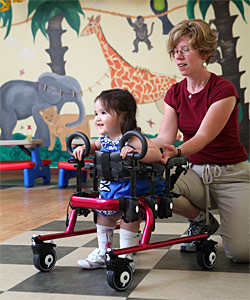Toby Long on Activity Focused Early Intervention
| February 2012Not long ago I had the opportunity to interview Toby Long, PT, PhD, FAPTA . As Associate Professor in the Department of Pediatrics at Georgetown University and Director of Training in the Division of Physical Therapy at the Center for Child and Human Development, she has expertise in the area of evaluation, assessment and service delivery to children with disabilities as well as in training professionals. I was impressed with her thoughts and experience and I think you will be too.

What is the most important outcome of pediatric therapy intervention?
Toby: Our ultimate outcome is for every child to be able to participate in society throughout their life, to become a contributing member to society. The International Classification of Functioning promotes this: they discuss participation as an important outcome that we should all be directing our efforts toward. In order for that to happen, from early on, we have to create opportunities for children to participate in life. Our therapy should be directed to help children develop the skills and strategies that allow this, or to help our communities to build environments and systems that facilitate this rather than creating barriers and preventing participation.
The natural environment affords a host of opportunities to participate. When we speak of “natural environments” we’re often referring only to places at home or at child care. I like to speak of “activities and routines.” What activities and routines do very young children do with their family on a regular basis? They will always eat, they will always sleep, and they will probably go to the grocery store with their family. But there are many more, and each family is different. Knowing these activities and routines helps us to embed our therapeutic strategies into activities that families find important.
For example, for a toddler to go to the grocery store with the parent, the child might need to sit in the grocery cart. But if a child has poor trunk stability they will have difficultly sitting in the cart, so grocery shopping provides an opportunity to practice better trunk posturing and reinforce that skill within that natural environment, right when that skill is needed.
Want to read more? In separate posts, Toby continues with these questions:
How does a therapist incorporate activity-based intervention into their practice?
Is there a role for assistive technology in activity-based intervention for children?





